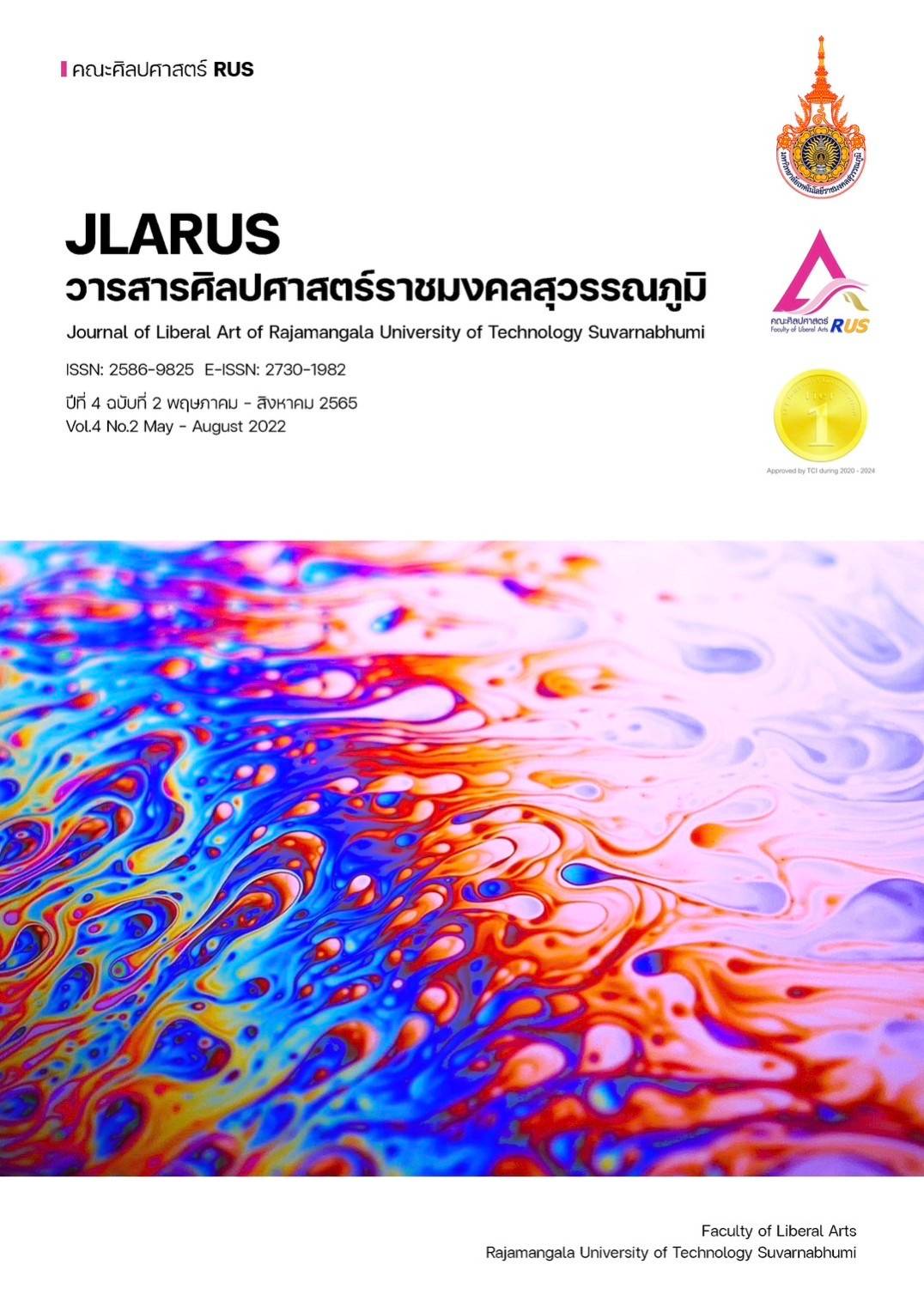STRATEGY IN PROMOTING THE WAT PHO MASSAGE DISCIPLINE, POST COVID-19 FOR CONFIDENCE AND SAFETY IN HEALTH
Main Article Content
Abstract
This qualitative research, “Strategy in Promoting the Wat Pho Massage Discipline (WPMD), post COVID-19 Era for Confidence and Safety in Health” is the third study in a research series of the same name. The objective was to synthesize the strategy for promoting the WPMD in the post COVID-19 era in order to build confidence in health safety. Content analysis was used to analyze the information obtained by five experts joining the focus group. The results from the analysis were synthesized with the results of research project 1: Study of the Satisfaction in the Quality of the Wat Pho Massage Discipline Services and those of research project 2: Study of the Guidelines for the Development of a Role Model Instructor, Wat Pho Massage Discipline, Post COVID-19 Era. Since “Thai massage - Nuad Thai” had been inscribed on UNESCO’s Representative List of the Intangible Cultural Heritage of Humanity in 2019, the research series were conducted with the purpose to develop and maintain the status of world heritage. Six strategies were synthesized: Strategy No. 1: Development of the curriculum of the WPMD and providing teaching and learning to achieve six learning outcomes. Strategy No. 2: Development of traditional Thai massage that had been integrated with the new normal life concept. Strategy No. 3: Extensive recruitment and selecting of fully qualified youth into the WPMD curriculum beginning from the academic year B.E. 2566 (2023). Strategy No. 4: Funding support in studying the WPMD from the community, by the community, to the community and internationally. Strategy No. 5: Define the criteria for the quality evaluation of WPMD masseuses for quality assurance. Strategy No. 6: Conduct institutional research and research on the service provided under the WPMD.
Article Details

This work is licensed under a Creative Commons Attribution-NonCommercial-NoDerivatives 4.0 International License.
References
กระทรวงสาธารณสุข. (2559). แผนพัฒนาสุขภาพแห่งชาติ ฉบับที่ 12 (พ.ศ. 2560-2564). นนทบุรี: กระทรวงสาธารณสุข.
กองการประกอบโรคศิลปะ. (2541). ตำราแพทย์แผนโบราณทั่วไป สาขาเภสัชกรรม. นนทบุรี: สำนักงานปลัดกระทรวงสาธารณสุข.
ขวัญเมือง แก้วดำเกิง. (2563). การใช้ชีวิตอย่างสมดุลและมีความสุข. วารสารสมาคมวิชาชีพสุขศึกษา, 35(2), 12-21.
นิตยา อภิรัตน์วรากุล, ธนกฤติ ทุริสุทธิ์ และสุภีร์ สมอนา. (2560). การพัฒนากลยุทธ์การตลาดของธุรกิจการนวดเพื่อสุขภาพในเขตเทศบาลนครอุดรธานี อำเภอเมือง จังหวัดอุดรธานี. วารสารวิชาการมหาวิทยาลัยราชภัฏอุดรธานี, 5(2), 35-50.
พจน์ บุญเรือง. (2522). เอกสารประกอบคำบรรยายวิชาการนิเทศการส่งเสริม, กรุงเทพมหานคร: คณะเกษตรศาสตร์. มหาวิทยาลัยเกษตรศาสตร์. (อัดสำเนา).
พระราชบัญญัติ สถานประกอบการเพื่อสุขภาพ พ.ศ. 2559. ราชกิจจานุเบกษา. 30 มีนาคม 2559, 10-24.
พวงทิพย์ ชัยพิบาลสฤษดิ์, อุไรวรรณ อมรนิมิตร, อาภาภรณ์ โพธิ์กระจ่าง, ปัณณิกา โพธิเวชเทวัญ และรุ่งลักษมี รอดขำ, (2564). ศึกษาแนวทางพัฒนาครูนวดต้นแบบ ตำรับวัดโพธิ์ หลังยุคโควิด-19. วารสารสุขภาพกับการจัดการสุขภาพ, 7(2), 154-167.
ภาณิกานต์ คงนันทะ. (2553). ปัจจัยที่มีอิทธิพลต่อการเลือกใช้บริการนวดแผนไทยของนักท่องเที่ยวต่างชาติบนถนนข้าวสารกรุงเทพมหานคร (วิทยานิพนธ์ปริญญาศิลปศาสตรมหาบัณฑิต). กรุงเทพมหานคร: มหาวิทยาลัยศิลปากร.
ศิริพร สว่างจิตร, วลัยพร ศิริภิรมณ์ และพฤทธิ์ ศิริบรรณพิทักษ์. (2560). การพัฒนากลยุทธ์การบริหารวิทยาลัยพยาบาลสังกัดกระทรวงกลาโหมตามแนวคิดการเป็นองค์การสมรรถนะสูง. วารสารพยาบาลทหารบก, 18(3), 180-191.
สมพิศ กองอังกาบ, อโณทัย งามวิชัยกิจ และลัดดา วัจนะสาลิกากุล. (2559). ปัจจัยส่วนประสมการตลาดที่มีผลต่อพฤติกรรมการใช้บริการนวดแผนไทย ในวัดพระเชตุพนวิมลมังคลารามราชวรมหาวิหาร. วารสารวิจัยและพัฒนาวไลยอลงกรณ์ ในพระบรมราชูปถัมภ์, 11(3), 295-304.
Bandura, A. (1986). Social foundations of thought and action: A social cognitive theory. New Jersey: Prentice-Hall, Inc.
Bandura, A. (1997). Self-efficacy: The exercise of control. New York: W.H. Freeman and Company.
Bloor, M., Frankland, J., Thomas, M., & Robson, K. (2001). Focus groups in social research. London: SAGE Publications.
Kotler, P. & Armstrong, G. (2009). Marketing, an Introduction. New Jersey: Pearson Prentice Hall.
Kitzinger, J. (1995). Qualitative research: Introducing focus groups. British Medical Journal, 311(7000), 299–302.
Lindlof, T. R., & Taylor, B. C. (2002). Qualitative Communication Research Methods. (2nd ed.). Thousand Oaks, California: Sage.
Parasuraman, A., Zeithaml, V. & Berry, L. (1988). SERVQUAL A multiple-item scale for measuring consumer perceptions of service quality. Journal of Retailing, 64(1), 12-40.
Tracy, S. J., Lutgen-Sandvik, P., & Alberts, J. K. (2006). Nightmares, demons and slaves: Exploring the painful metaphors of workplace bullying. Management Communication Quarterly, 20(2), 148-185.
World Health Organization. (2010). Benchmarks for training in traditiona/complementary and alternative medicine: Benchmarks for training in Nuad Thai. Geneva: WHO Press. สืบค้น 16 พฤษภาคม 2563. จาก https://sites.google.com/site/prachyasersthkicphxpheiyngcom/prawati-phu-cad-tha.


